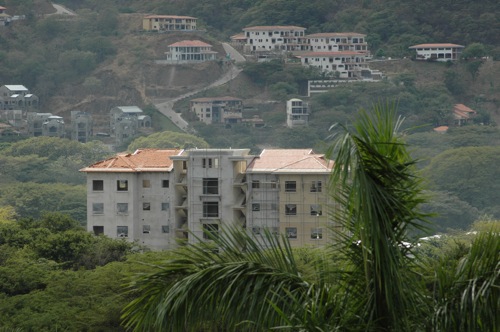Although this is the dry season in Guanacaste province, which is in the north of the country, we were delayed getting from Liberia airport to our hotel due to recent flooding that had damaged a bridge. While enjoying daredevil driving, I had a chance to acclimate from the snowstorm I had just left in Boston to the hot and humid Central American weather.
The primary artery from the airport to the coast is a two lane road. Much of the country is like this, with critical infrastructure in need of repair and major transportation arteries seriously undersized. While Costa Rica, a highly progressive and environmentally-friendly nation, hopes to become carbon-neutral within the next 20 years, problems of infrastructure threaten to hamper those goals. Idling cars do not make reducing emissions any easier.

That said, Costa Rica’s energy generation is nearly 99% renewable, with a substantial majority of it coming from hydroelectric and geothermal sources — dams and volcanoes, to put it simply. Now, dams aren’t always entirely environmentally friendly, but geothermal energy has a pretty good track record, and CR even exports electricity to Panama and other neighboring countries.
Speaking of neighbors, we learned that the country has a bit of an immigration problem. Nicaraguan laborers from the north come to CR en masse during harvest season. Nicaraguan mango pickers work long days in the groves, looking up into trees and using a blade and basket assembly on a pole to pick ripe mangoes and pack them into crates. One basket usually holds 30-40 mangoes (depending on size) and they are paid about 200 colones (40 cents) per basket.
Mirroring the American immigration problem, dueling forcers are at work: the need for cheap, abundant labor to perform jobs that the general population is not willing or able to perform for the wages offered, and concern about rising crime and the cost of social services, both problems that can be pinned, justified or not, on the migrant community. There are differences, though. For one, Ticos and Nicas share a language and similar cultural traditions. Less than a quarter century ago Nicaragua was a more prosperous land than its neighbor to the South, but years of war and internal strife led Nicaragua to its present economic situation.
When we asked a guide about his feelings on the immigration wave, he said that while others may think badly of he Nicaraguan community, he is a supporter of their plight, has Nicaraguan friends, and has a Nicaraguan flag hanging in his house. So far we have not encountered any Nicaraguan xenophobes, but then we haven’t exactly been looking.

All around our hotel are condominium units built or under construction for rich American (and sometimes European) ex-pats. The top industry in Costa Rica is tourism, bringing in $1.7 billion annually and making the nation the most visited in the region. Next up is high technology, thanks to a concerted push in the last decade to bring in outside technology investment through major tax incentives. Intel is here, and a tour guide told us with evident pride that it was Costa Rican scientists who developed and a Costa Rican fab that is producing Intel’s newest Penryn processor. Fitting, as the Penryn uses a new low-power, high-performance design.
The third major industry in CR is agriculture. Fruit, cattle, and sugarcane are major crops.
I’ve run out of internet time (frittered away fact checking!), so next time I’ll talk bout our first adventure tour (the “Mega Combo” package!) and post some pictures. Until then.